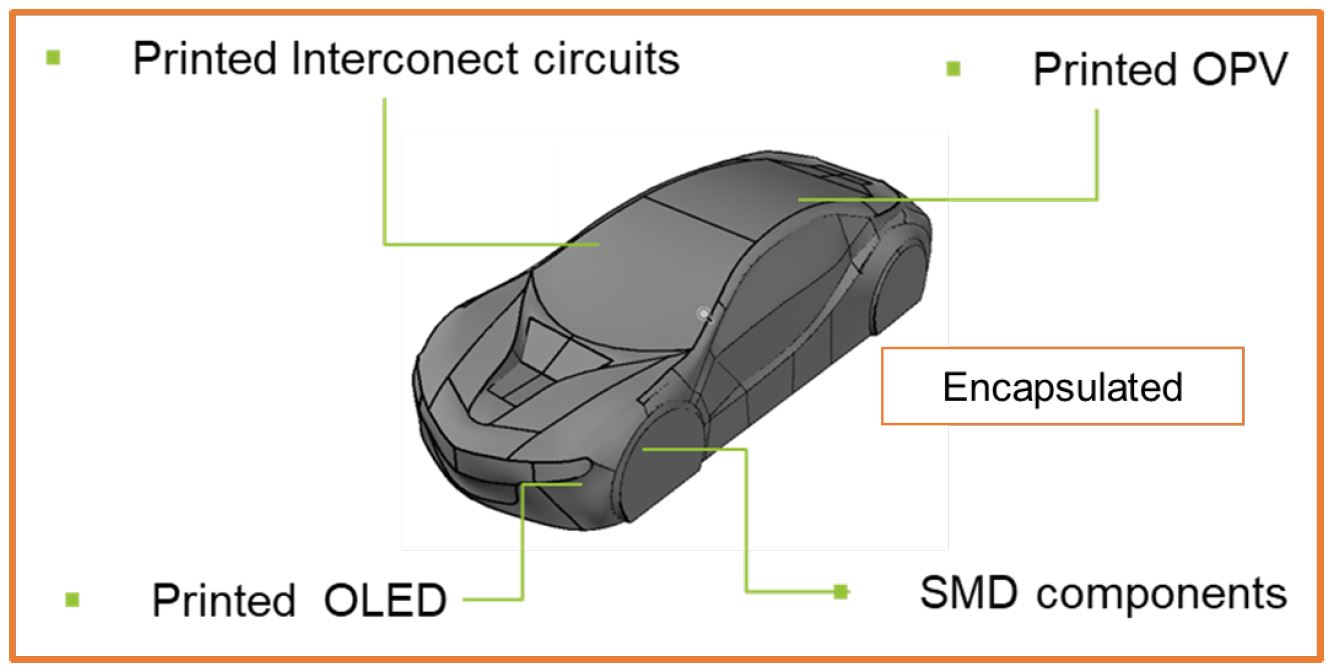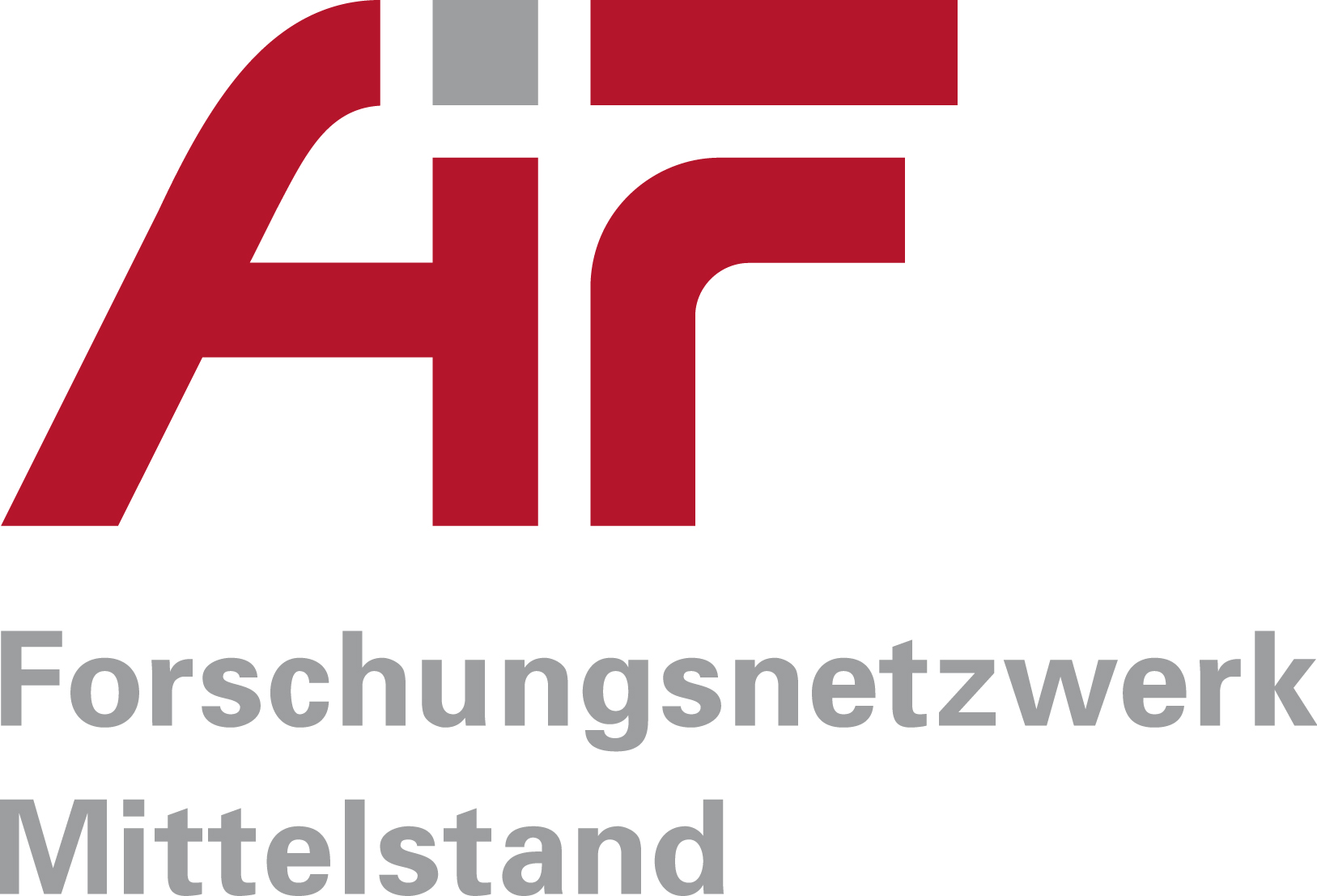Summary of the final report of the research project: IGF Project 19854 N – OLE-3D
“Digital printing of organic optoelectronics on a 3D body”
The OLE-3D project of the two institutes ZAE Bayern and FAPS was successfully completed with the production of a functional 3D demonstrator. In the course of the project, organic materials were adapted for inkjet printing and aerosol jet printing in order to realise solution-based electronic components by means of digital printing. Subsequently, an inkjet print head was integrated into a 5-axis robot system with which the printing of organic electronics on 3D bodies could be realised. This demonstrated for the first time that organic components can be produced directly on various surfaces in a functional way in air using digital printing. The resulting possibilities in various industries are very diverse. For example, car parts or consumer products or consumer electronics can be equipped with additional functionalities, such as light or power generation. Thus, the applications range from the automotive industry to medical technology to plastics manufacturing. Only the lifetimes of the components need to be improved by developing suitable encapsulation processes, which can be done in the course of a follow-up project based on the results so far.
Motivation
Current technological progress is leading to ever greater demands on technical products and their components. Thus, by integrating more functions into one component, the integration density and material costs can be optimised. For the production of printed circuit boards, the conductor tracks are usually structured directly on the dielectric board by means of etching processes. This is usually achieved by photolithographic processes in which the desired structure for the etching process is created by light and corresponding optical masks. However, this technology only creates 2D geometries for tracks and components. The associated soldering process for attaching components to the PCB also leads to similar limitations with regard to the shape and geometry of the carrier. These limitations can be circumvented by using new technologies such as organic electronic components and additive manufacturing methods. This thus offers the possibility of attaching electronic components directly to surfaces of different materials and products. This also offers the potential to functionalise any 3D body to generate electricity or light, thereby significantly shortening process chains. This is possible, for example, by means of organic solar cells (OSC), photodetectors (OPD) and organic light-emitting diodes (OLED), which can be attached to curved surfaces by means of direct printing processes, while further conductive tracks and electronic components are applied to the reverse side by means of moulded interconnect devices (MID). The possible applications for such components are very diverse. For example, lights can be applied directly to injection-moulded car parts or mobile phone covers can be equipped with additional features such as current generation or sensor technology without having to implement this in many process steps using separate components. Applications in medical diagnostics, clothing, accessories, etc. are also very feasible here.
In this project, the necessary processes for direct printing of organic functional materials for electrical components on 3D objects were therefore developed. The focus was primarily on contactless digital printing, especially inkjet and aerosoljet printing, which are perfectly suited for use with functional inks and with which any shape can be printed on almost any substrate. By suitably modifying the processes and ink formulations, printing on curved surfaces is possible. In the next step, available electrical contacts can be tested directly on 3D components in order to realise a connection to components in the periphery or to surface-mounted technology (SMT) components. The functional 3D components developed in this way must then be compared with analogue 2D objects, especially with regard to long-term stability and reliability of the products. These technologies thus enable enormous progress in many market areas and, above all, expansion in previously impossible or expensive product segments.
Summary and future research and development
In the OLE3D project, it was shown that the concept of functionalising arbitrary 3D bodies with organic (opto-)electronic devices can be realised in an industrial environment by combining a 5-axis robot with aerosol and inkjet printing. For IJ printing, it was possible to develop suitable inks for all layers of organic solar cells and OLEDs, including transparent electrodes. This allowed the production of a fully IJ-printed and fully functional demonstrator, a “midster” functionalised with OLEDs. In the area of aerosol jet printing of OEDs, it was demonstrated that transparent electrodes, hole-conducting layers and conductor paths can be printed functionally.
- The complete automation of the printing apparatus
- The implementation of AJ printing in the 5-axis apparatus
- Development of the inks for the application of the active layer and ETL using AJ printing
- Optimisation of AJ printing of AgNW to eliminate as much as possible the reduction of the aspect ratio of AgNW by the printing process
- Extending the life of the OEDs

Figure: Schematic representation of a multifunctional 3D component with various OED components;
Source: ZAE Bayern, FAPS (FAU)
Due to their lack of encapsulation, the organic components are not sufficiently protected from oxygen and water, so that an application-relevant longevity is not yet given. For this reason, an important field of development is the production of printed barriers on 3D objects. Since the methods used so far are mostly based on expensive vacuum processes and are therefore not suitable for 3D (shadowing effects prevent a homogeneous coating), the printing of such layers is of particular importance. Since this project has shown that PHPS is not only a good solution-processable barrier layer but also a suitable intermediate layer for the planarisation of the substrates, a promising start can already be made at this point.
Further information on the project can be found here.



